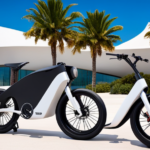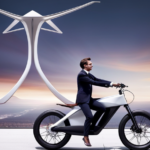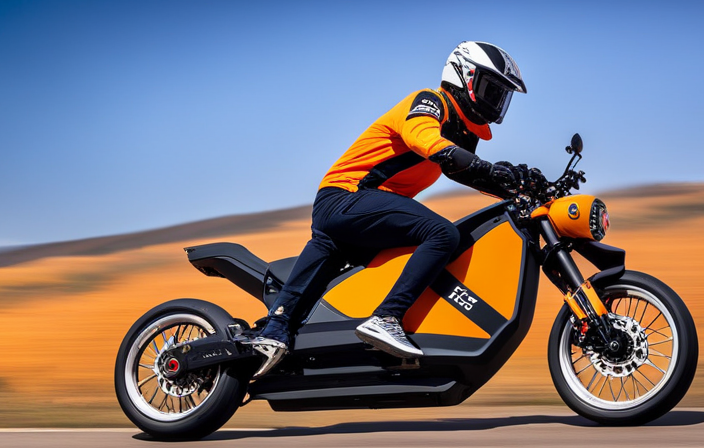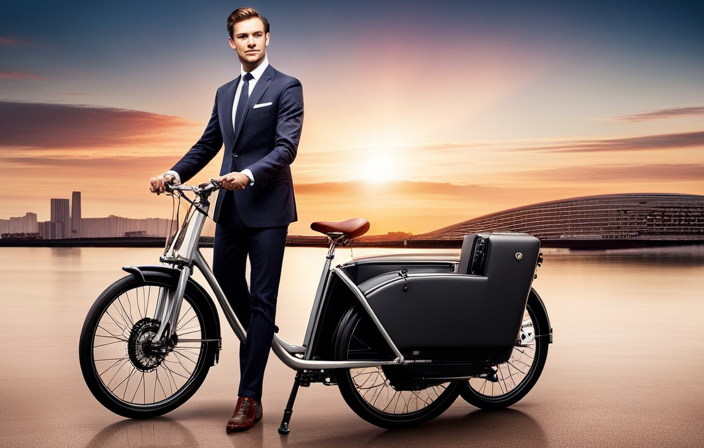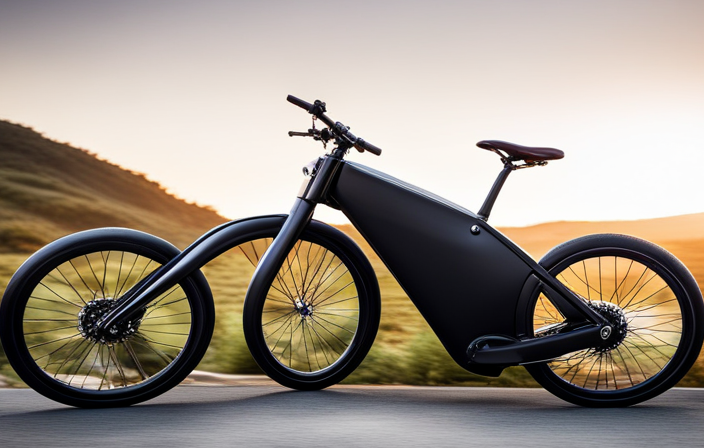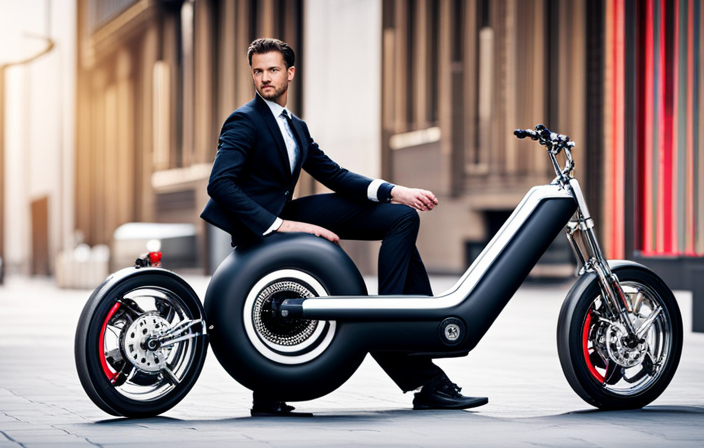Ah, the humble frame. Often overlooked, yet undeniably crucial to the performance and functionality of an electric bike. It serves as the backbone, providing support and stability for the entire contraption.
But what exactly is a frame? Well, my curious reader, prepare to have your electric bike knowledge expanded. In this article, we will delve into the intricacies of electric bike frames, exploring their importance, types, materials, and even maintenance tips.
So buckle up and get ready to dive into the fascinating world of electric bike frames.
Key Takeaways
- Electric bike frames have seen advancements in terms of higher speeds with less effort, as well as the integration of battery systems for improved weight distribution and balance.
- Regular maintenance and care of electric bike frames, such as cleaning, inspecting for cracks and loose components, and applying protective measures, are important for ensuring longevity, performance, and safety.
- Common issues with electric bike frames include paint chips, rust, loose bolts, cracks, and dents, which should be addressed promptly to prevent further damage.
- The future of electric bike frames involves continuous experimentation with new materials, such as aluminum and carbon fiber, as well as advancements in frame design to enhance overall performance, comfort, and the overall biking experience.
Importance of the Frame in an Electric Bike
The frame is crucial in an electric bike because it determines the overall stability and durability of the bike. The importance of weight cannot be overstated, as a heavy frame can hinder the bike’s performance and make it difficult to maneuver.
A well-designed frame, on the other hand, can provide a lightweight and sturdy structure that enhances the bike’s overall efficiency. Additionally, the frame has a significant impact on the battery life of an electric bike. A lightweight frame reduces the strain on the battery, allowing for longer rides and increased range.
The function of the frame in providing support and stability is essential for a smooth and comfortable ride. It ensures that the bike remains steady even at high speeds or on rough terrains, allowing the rider to maintain control and enjoy a safe journey.
Function of the Frame in Providing Support and Stability
When you ride, your electric bike’s structure ensures stability and support. The frame of an electric bike plays a crucial role in providing this support and stability. The frame construction and materials used are essential factors in determining the overall performance and durability of the bike. Electric bike frames are typically made from materials such as aluminum, steel, carbon fiber, or a combination of these materials. Each material has its own set of advantages and disadvantages. Aluminum frames, for example, are lightweight and corrosion-resistant, making them popular among electric bike manufacturers. Steel frames, on the other hand, offer excellent strength and durability, but can be heavier. Carbon fiber frames are known for their stiffness and lightness, but they can be more expensive. These frame materials are carefully chosen to ensure the bike’s stability and support while riding. In the subsequent section, we will explore the different types of frames used in electric bikes, highlighting their unique features and benefits.
Different Types of Frames Used in Electric Bikes
To explore the different types of frames used in electric bikes, let’s take a look at the unique features and benefits they offer.
Electric bike frames can be made from various materials, including aluminum, steel, carbon fiber, and titanium. Each material has its own advantages and characteristics.
Aluminum frames are lightweight, durable, and affordable. Steel frames provide strength and comfort, absorbing road vibrations. Carbon fiber frames are incredibly lightweight and offer excellent stiffness, allowing for efficient power transfer. Titanium frames combine the best of both worlds, with strength, durability, and a lightweight design.
One advantage of a rigid frame is its stability, allowing for better control and handling.
Understanding the materials used in electric bike frames is crucial to choosing the right one for your needs. Now, let’s delve into the details of these materials.
Understanding the Materials Used in Electric Bike Frames
Understanding the materials used in electric bike frames is essential for selecting the right one for your needs. The choice of materials greatly affects the performance, durability, and weight of the frame.
Here are four key materials commonly used in electric bike frame construction:
-
Aluminum: Lightweight and corrosion-resistant, aluminum frames offer a balance of strength and affordability.
-
Carbon Fiber: Known for its exceptional strength-to-weight ratio, carbon fiber frames provide a lightweight and stiff structure for enhanced performance.
-
Steel: Renowned for its durability and strength, steel frames offer a smooth and comfortable ride, albeit at a heavier weight.
-
Titanium: Combining strength, durability, and lightness, titanium frames are known for their high performance and longevity.
Considering the materials used in electric bike frames is just the first step in selecting the right frame. Factors such as geometry, suspension, and intended use should also be taken into account.
Factors to Consider When Choosing an Electric Bike Frame
One important factor to consider when choosing an e-bike frame is the intended use and terrain. The frame materials and geometry play a crucial role in determining the overall performance and durability of the bike.
The frame materials commonly used in electric bike frames include aluminum, steel, carbon fiber, and titanium. Aluminum is lightweight and affordable, while steel offers excellent strength and durability. Carbon fiber is the lightest and provides superior vibration dampening, but it can be expensive. Titanium is a premium option known for its strength and corrosion resistance.
Frame geometry also plays a key role in determining the bike’s handling and comfort. Factors such as the head tube angle, seat tube angle, and chainstay length affect how the bike responds to different terrains.
Understanding frame materials and geometry will help you choose the perfect e-bike for your needs.
Moving on to how the frame design affects the riding experience…
How the Frame Design Affects the Riding Experience
The design of the frame greatly impacts the overall riding experience, influencing factors such as stability, maneuverability, and comfort. When considering an electric bike frame, it is important to understand how different frame materials affect durability.
Aluminum frames are lightweight and resistant to corrosion, making them a popular choice. However, they may not be as durable as steel frames, which are heavier but offer better strength. Carbon fiber frames are the lightest and provide excellent shock absorption, but they can be more expensive.
Additionally, the weight of the frame plays a significant role in the handling and maneuverability of the electric bike. A lighter frame allows for easier acceleration and maneuvering, while a heavier frame may provide better stability.
In conclusion, understanding the impact of frame materials and weight on the riding experience is crucial in selecting the right electric bike. This knowledge sets the stage for exploring the relationship between frame geometry and performance.
The Relationship Between Frame Geometry and Performance
When considering an electric bicycle, it’s important to take into account how the geometry of the frame impacts overall performance.
Frame geometry refers to the angles, lengths, and positioning of the various components that make up the frame. These factors play a crucial role in determining how the bike handles and performs in different situations. A well-designed frame geometry can enhance the stability, agility, and responsiveness of the electric bike.
Additionally, the frame material selection also plays a vital role in determining the overall performance of the bike. Different materials have different properties, such as stiffness and weight, which can significantly impact the bike’s performance. Therefore, choosing the right frame geometry and material is essential for achieving optimal performance.
Moving forward, let’s explore the innovations in electric bike frame technology, which have further improved the performance of these bikes.
Innovations in Electric Bike Frame Technology
Innovations in electric bike frame technology have greatly enhanced overall performance. One major innovation is the use of carbon fiber frames. Carbon fiber is incredibly lightweight yet strong, making it an ideal material for electric bike frames. These frames offer improved power transfer and responsiveness, allowing riders to achieve higher speeds with less effort.
Additionally, carbon fiber frames absorb vibrations better than traditional materials, resulting in a smoother and more comfortable ride. Another innovation is the integration of battery systems into the frame. This design not only improves the aesthetics of the bike but also allows for better weight distribution and balance. Integrated battery systems also make it easier to remove and replace the battery when needed.
With these advancements, electric bike frames have become more efficient and durable. Transitioning into the next section on maintenance and care, it is important to understand how to properly maintain these advanced frames.
Maintenance and Care Tips for Electric Bike Frames
To keep your electric bike’s frame in optimal condition, regular cleaning and inspection are essential. Proper maintenance ensures that your frame will remain sturdy and reliable, allowing you to enjoy a smooth and safe ride. Here are some maintenance tips to help you take care of your electric bike frame.
First, it’s important to clean your frame regularly. Use a mild detergent and a soft cloth or sponge to remove any dirt or grime that may have accumulated. Be sure to pay attention to hard-to-reach areas, such as the bottom bracket and headset.
In addition to cleaning, inspecting your frame for any signs of damage is crucial. Check for any cracks, dents, or loose components. If you notice any issues, it’s best to have them addressed by a professional bike mechanic.
Common issues that can arise with electric bike frames include paint chips, rust, and loose bolts. To prevent paint chips, consider applying a protective film or clear coat. To avoid rust, keep your bike stored in a dry place and wipe down any moisture after riding in wet conditions. Lastly, regularly check and tighten any loose bolts to maintain the structural integrity of your frame.
In conclusion, proper maintenance and care of your electric bike frame is essential for its longevity and performance. By following these maintenance tips and addressing any common issues promptly, you can ensure that your electric bike frame remains in great shape.
As we look towards the future of electric bike frames and emerging trends, it’s important to stay informed about advancements in frame materials, design, and manufacturing processes.
The Future of Electric Bike Frames and Emerging Trends
Now that we’ve discussed maintenance and care tips for electric bike frames, let’s explore the future of electric bike frames and the emerging trends in this exciting industry.
When it comes to electric bike frame materials, manufacturers are continuously experimenting with new options to enhance performance and durability. While aluminum frames have been the go-to choice for many years due to their lightweight nature, carbon fiber frames are gaining popularity for their strength and stiffness. These materials not only contribute to the overall weight reduction of the bike but also have a significant impact on the bike’s performance and comfort.
In addition to materials, frame design plays a crucial role in the performance and comfort of electric bikes. Factors such as geometry, suspension systems, and integration of components can greatly influence how the bike handles different terrains and how comfortable the ride feels.
As the electric bike industry continues to evolve, we can expect to see further advancements in frame materials and designs, ultimately resulting in more efficient and enjoyable rides.
Frequently Asked Questions
Are all electric bike frames the same size?
No, electric bike frame sizes can vary depending on the model and brand. They are typically made from lightweight materials such as aluminum or carbon fiber to ensure durability and enhance performance.
Can I use a regular bicycle frame for an electric bike conversion?
Yes, a regular bicycle frame can be used for an electric bike conversion. However, it’s important to consider electric bike frame compatibility. Purpose-built electric bike frames offer advantages such as better weight distribution and integration of components for optimal performance.
Does the frame material affect the weight of the electric bike?
Does the frame material affect the weight of the electric bike? Absolutely. The frame material plays a crucial role in determining the bike’s weight, durability, and overall performance. Choosing a strong, lightweight material is essential for optimal electric bike performance.
How does the frame design impact the comfort of the rider?
The frame design of an electric bike greatly impacts the comfort of the rider. Optimal frame geometry ensures proper body positioning and reduces strain. Suspension systems further enhance rider comfort by absorbing shocks and vibrations from uneven terrain.
Are there any specific maintenance requirements for electric bike frames compared to regular bicycle frames?
Electric bike frame maintenance involves regular cleaning and inspection for any signs of wear or damage. Additionally, it is important to ensure that all electrical components are properly secured and protected. The benefits of electric bike frames over regular bicycle frames include increased durability and the ability to support the added weight of the electric motor and battery.
Conclusion
In conclusion, the frame of an electric bike plays a crucial role in providing support and stability, making it an essential component. Different types of frames, such as step-through, diamond, and folding frames, offer various benefits depending on the rider’s needs.
Understanding the materials used in electric bike frames, such as aluminum, steel, and carbon fiber, is key in selecting the most suitable option. Factors like frame geometry and innovations in frame technology further enhance the bike’s performance.
Proper maintenance and care ensure the longevity of the frame, while emerging trends hint at an exciting future for electric bike frames.



